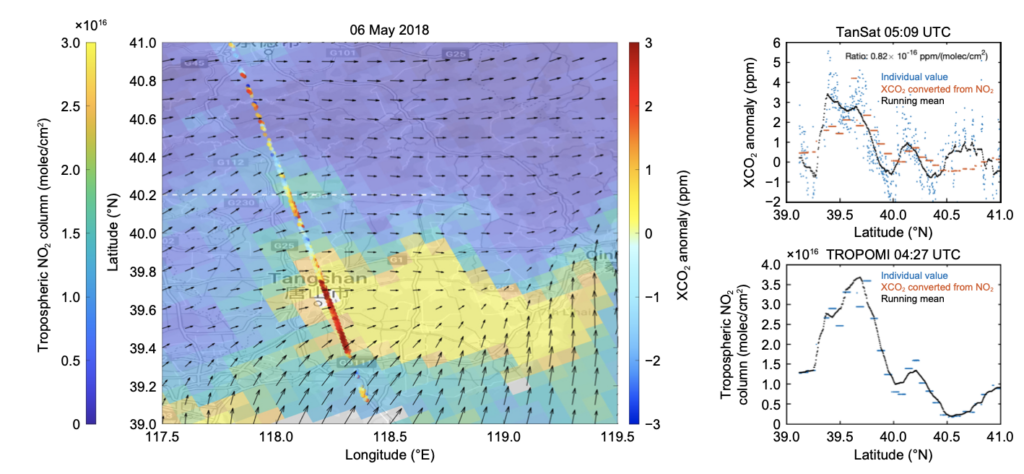Launched in 2016, TanSat is China’s first global carbon dioxide monitoring satellite. Tan is the Chinese pronunciation of carbon. While TanSat has been providing researchers with data for several years, new algorithms were recently added to the TanSat instruments that greatly improved TanSat’s measurement precision.
The research team conducted their study by looking at two sets of measurements collected over two cities. The scientists used TanSat carbon dioxide data captured in May 2018 near Tangshan, China, and in March 2018 near Tokyo, Japan. They compared the TanSat data to nitrogen dioxide measurements captured by the TROPOspheric Monitoring Instrument onboard the Copernicus Sentinel-5 Precursor satellite on the same dates over the same cities.
“We analyzed TanSat data in synergy with European Copernicus Sentinel-5 Precursor TROPOMI nitrogen dioxide observations to help the detection of anthropogenic plumes and to analyze the carbon dioxide-to-nitrogen dioxide ratio,” said Dongxu Yang, from the Institute of Atmospheric Physics, Chinese Academy of Sciences.

Their two case studies show TanSat carbon dioxide measurements have the capability to capture the anthropogenic variations in the plume and have spatial patterns like that of the TROPOspheric Monitoring Instrument’s nitrogen dioxide observations. In addition, the carbon dioxide-to-nitrogen dioxide ratio in Tangshan, China, and Tokyo, Japan, align with the emission inventories.
“This is an important step in TanSat data analysis. The next step is to infer emissions and to prepare for the TanSat-2 constellation including the joint analysis of CO2 and NO2 plumes,” said Janne Hakkarainen, from the Finnish Meteorological Institute.
Looking ahead, the team has plans to expand this research. “The TanSat is our first attempt on global carbon monitoring. The next generation of China’s Global Carbon Dioxide Monitoring Satellite mission, TanSat-2, is now in the design phase,” said Yi Liu, from the Institute of Atmospheric Physics, Chinese Academy of Sciences.
According to Liu, TanSat-2’s target measurements will focus on cities with an 800-1000 kilometer (500-620 mile) wide swath to record the gradient of carbon dioxide from city central to rural areas using an imaging process and a 500-meter (1600-foot) footprint size to improve the emission estimation accuracy. TanSat-2 will be a constellation of satellites distributed into at least two orbits in the morning and afternoon to cover a city or a point source twice a day.
“Our goal is to use satellite measurements to improve our knowledge of the carbon cycle and to further analyze and constraint the carbon dioxide sources and sinks and their uncertainties,” said Liu.
Reference: “Detection of Anthropogenic CO2 Emission Signatures with TanSat CO2 and with Copernicus Sentinel-5 Precursor (S5P) NO2 Measurements: First Results” by Dongxu Yang, Janne Hakkarainen, Yi Liu, Iolanda Ialongo, Zhaonan Cai and Johanna Tamminen, 25 October 2022, Advances in Atmospheric Sciences. https://doi.org/10.1007/s00376-022-2237-5